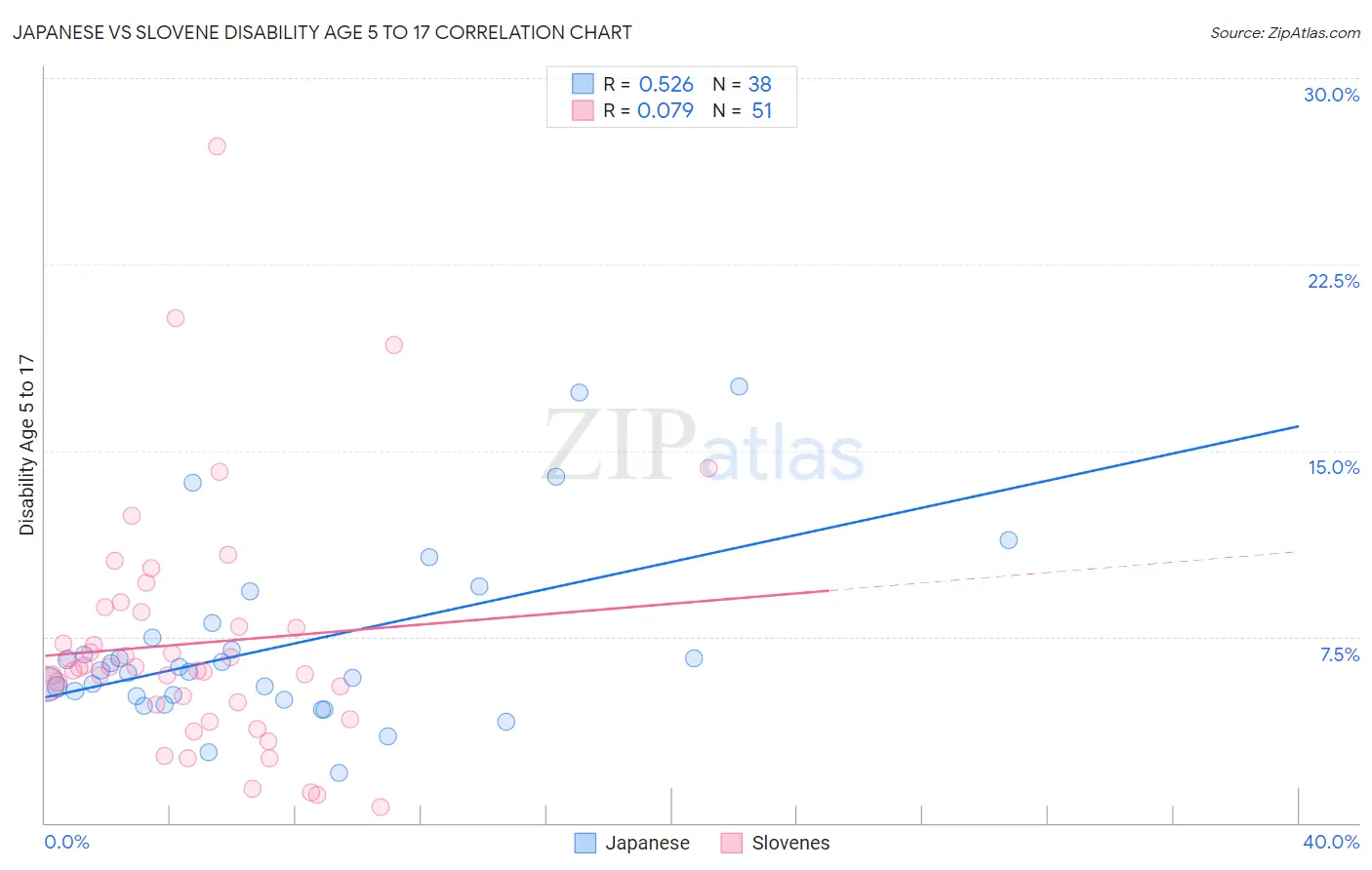Japanese vs Slovene Disability Age 5 to 17
COMPARE
Japanese
Slovene
Disability Age 5 to 17
Disability Age 5 to 17 Comparison
Japanese
Slovenes
6.1%
DISABILITY AGE 5 TO 17
0.1/ 100
METRIC RATING
276th/ 347
METRIC RANK
6.0%
DISABILITY AGE 5 TO 17
0.6/ 100
METRIC RATING
266th/ 347
METRIC RANK
Japanese vs Slovene Disability Age 5 to 17 Correlation Chart
The statistical analysis conducted on geographies consisting of 248,392,506 people shows a substantial positive correlation between the proportion of Japanese and percentage of population with a disability between the ages 5 and 17 in the United States with a correlation coefficient (R) of 0.526 and weighted average of 6.1%. Similarly, the statistical analysis conducted on geographies consisting of 259,532,016 people shows a slight positive correlation between the proportion of Slovenes and percentage of population with a disability between the ages 5 and 17 in the United States with a correlation coefficient (R) of 0.079 and weighted average of 6.0%, a difference of 1.6%.

Disability Age 5 to 17 Correlation Summary
| Measurement | Japanese | Slovene |
| Minimum | 2.0% | 0.63% |
| Maximum | 17.6% | 27.3% |
| Range | 15.6% | 26.6% |
| Mean | 7.1% | 7.2% |
| Median | 6.1% | 6.2% |
| Interquartile 25% (IQ1) | 5.1% | 4.8% |
| Interquartile 75% (IQ3) | 7.5% | 8.5% |
| Interquartile Range (IQR) | 2.4% | 3.7% |
| Standard Deviation (Sample) | 3.6% | 4.9% |
| Standard Deviation (Population) | 3.5% | 4.9% |
Demographics Similar to Japanese and Slovenes by Disability Age 5 to 17
In terms of disability age 5 to 17, the demographic groups most similar to Japanese are Dutch (6.0%, a difference of 0.11%), Cheyenne (6.0%, a difference of 0.21%), Alaska Native (6.0%, a difference of 0.33%), Finnish (6.0%, a difference of 0.38%), and Immigrants from Zaire (6.0%, a difference of 0.40%). Similarly, the demographic groups most similar to Slovenes are Panamanian (6.0%, a difference of 0.030%), Canadian (6.0%, a difference of 0.10%), Spanish (6.0%, a difference of 0.11%), Czechoslovakian (5.9%, a difference of 0.22%), and Immigrants from Western Africa (5.9%, a difference of 0.30%).
| Demographics | Rating | Rank | Disability Age 5 to 17 |
| Immigrants | Middle Africa | 0.7 /100 | #261 | Tragic 5.9% |
| Immigrants | Western Africa | 0.7 /100 | #262 | Tragic 5.9% |
| Czechoslovakians | 0.7 /100 | #263 | Tragic 5.9% |
| Canadians | 0.6 /100 | #264 | Tragic 6.0% |
| Panamanians | 0.6 /100 | #265 | Tragic 6.0% |
| Slovenes | 0.6 /100 | #266 | Tragic 6.0% |
| Spanish | 0.5 /100 | #267 | Tragic 6.0% |
| Sioux | 0.4 /100 | #268 | Tragic 6.0% |
| Liberians | 0.4 /100 | #269 | Tragic 6.0% |
| Immigrants | Somalia | 0.4 /100 | #270 | Tragic 6.0% |
| Immigrants | Zaire | 0.2 /100 | #271 | Tragic 6.0% |
| Finns | 0.2 /100 | #272 | Tragic 6.0% |
| Alaska Natives | 0.2 /100 | #273 | Tragic 6.0% |
| Cheyenne | 0.2 /100 | #274 | Tragic 6.0% |
| Dutch | 0.2 /100 | #275 | Tragic 6.0% |
| Japanese | 0.1 /100 | #276 | Tragic 6.1% |
| Puget Sound Salish | 0.1 /100 | #277 | Tragic 6.1% |
| Immigrants | Liberia | 0.1 /100 | #278 | Tragic 6.1% |
| Immigrants | Jamaica | 0.1 /100 | #279 | Tragic 6.1% |
| Portuguese | 0.1 /100 | #280 | Tragic 6.1% |
| Scottish | 0.0 /100 | #281 | Tragic 6.1% |